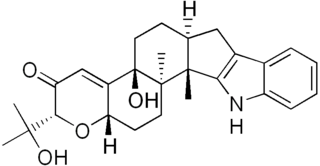
Ergoline is a chemical compound whose structural skeleton is contained in a variety of alkaloids, referred to as ergoline derivatives or ergoline alkaloids. Ergoline alkaloids, one being ergine, were initially characterized in ergot. Some of these are implicated in the condition ergotism, which can take a convulsive form or a gangrenous form. Even so, many ergoline alkaloids have been found to be clinically useful. Annual world production of ergot alkaloids has been estimated at 5,000–8,000 kg of all ergopeptines and 10,000–15,000 kg of lysergic acid, used primarily in the manufacture of semi-synthetic derivatives.

An endophyte is an endosymbiont, often a bacterium or fungus, that lives within a plant for at least part of its life cycle without causing apparent disease. Endophytes are ubiquitous and have been found in all species of plants studied to date; however, most of the endophyte/plant relationships are not well understood. Some endophytes may enhance host growth, nutrient acquisition and improve the plant's ability to tolerate abiotic stresses, such as drought, salinity and decrease biotic stresses by enhancing plant resistance to insects, pathogens and herbivores.

Phytochemistry is the study of phytochemicals, which are chemicals derived from plants. Phytochemists strive to describe the structures of the large number of secondary metabolites found in plants, the functions of these compounds in human and plant biology, and the biosynthesis of these compounds. Plants synthesize phytochemicals for many reasons, including to protect themselves against insect attacks and plant diseases. The compounds found in plants are of many kinds, but most can be grouped into four major biosynthetic classes: alkaloids, phenylpropanoids, polyketides, and terpenoids.

Paxilline is a toxic, tremorgenic diterpene indole polycyclic alkaloid molecule produced by Penicillium paxilli which was first characterized in 1975. Paxilline is one of a class of tremorigenic mycotoxins, is a potassium channel blocker, and is potentially genotoxic.

Ergocryptine is an ergopeptine and one of the ergot alkaloids. It is isolated from ergot or fermentation broth and it serves as starting material for the production of bromocriptine.

A loline alkaloid is a member of the 1-aminopyrrolizidines, which are bioactive natural products with several distinct biological and chemical features. The lolines are insecticidal and insect-deterrent compounds that are produced in grasses infected by endophytic fungal symbionts of the genus Epichloë. Lolines increase resistance of endophyte-infected grasses to insect herbivores, and may also protect the infected plants from environmental stresses such as drought and spatial competition. They are alkaloids, organic compounds containing basic nitrogen atoms. The basic chemical structure of the lolines comprises a saturated pyrrolizidine ring, a primary amine at the C-1 carbon, and an internal ether bridge—a hallmark feature of the lolines, which is uncommon in organic compounds—joining two distant ring carbons. Different substituents at the C-1 amine, such as methyl, formyl, and acetyl groups, yield loline species that have variable bioactivity against insects. Besides endophyte–grass symbionts, loline alkaloids have also been identified in some other plant species; namely, Adenocarpus species and Argyreia mollis.

Torreyanic acid is a dimeric quinone first isolated and by Lee et al. in 1996 from an endophyte, Pestalotiopsis microspora. This endophyte is likely the cause of the decline of Florida torreya, an endangered species that is related to the taxol-producing Taxus brevifolia. The natural product was found to be cytotoxic against 25 different human cancer cell lines with an average IC50 value of 9.4 µg/mL, ranging from 3.5 (NEC) to 45 (A549) µg/mL. Torreyanic acid was found to be 5-10 times more potent in cell lines sensitive to protein kinase C (PKC) agonists, 12-o-tetradecanoyl phorbol-13-acetate (TPA), and was shown to cause cell death via apoptosis. Torreyanic acid also promoted G1 arrest of G0 synchronized cells at 1-5 µg/mL levels, depending on the cell line. It has been proposed that the eukaryotic translation initiation factor EIF-4a is a potential biochemical target for the natural compound.
Aspergillus ochraceus is a mold species in the genus Aspergillus known to produce the toxin ochratoxin A, one of the most abundant food-contaminating mycotoxins, and citrinin. It also produces the dihydroisocoumarin mellein. It is a filamentous fungus in nature and has characteristic biseriate conidiophores. Traditionally a soil fungus, has now began to adapt to varied ecological niches, like agricultural commodities, farmed animal and marine species. In humans and animals the consumption of this fungus produces chronic neurotoxic, immunosuppressive, genotoxic, carcinogenic and teratogenic effects. Its airborne spores are one of the potential causes of asthma in children and lung diseases in humans. The pig and chicken populations in the farms are the most affected by this fungus and its mycotoxins. Certain fungicides like mancozeb, copper oxychloride, and sulfur have inhibitory effects on the growth of this fungus and its mycotoxin producing capacities.
Fumigaclavine B O-acetyltransferase is an enzyme with systematic name acetyl-CoA:fumigaclavine B O-acetyltransferase. This enzyme catalyses the following chemical reaction

Cerevisterol (5α-ergosta-7,22-diene-3β,5,6β-triol) is a sterol. Originally described in the 1930s from the yeast Saccharomyces cerevisiae, it has since been found in several other fungi and, recently, in deep water coral. Cerevisterol has some in vitro bioactive properties, including cytotoxicity to some mammalian cell lines.
Fumigaclavine A dimethylallyltransferase is an enzyme with systematic name dimethylallyl-diphosphate:fumigaclavine A dimethylallyltransferase. This enzyme catalyses the following chemical reaction

Fumigaclavine C is an ergoline alkaloid produced by Aspergillus fumigatus.

Fumigaclavine B is an ergoline compound made by certain fungi.

(-)-Versicolamide B and (+)-Versicolamide B are spiroindole alkaloids isolated from the fungus Aspergillus that belong to a class of naturally occurring 2,5-diketopiperazines. The versicolamides are structurally complex spiro-cyclized versions of prenylated cyclo(L-Trp-L-Pro) derivatives which possess a unique spiro-fusion to a pyrrolidine at the 3-position of the oxindole core together with the bicyclo[2.2.2]diazaoctane ring system. While (-)-versicolamide B was isolated from the marine fungus Aspergillus sp. the enantiomer (+)-versicolamide B was isolated from the terrestrial fungi Aspergillus versicolor NRRL. The total asymmetric syntheses of both enantiomers have been achieved and the implications of their biosynthesis have been investigated.

Fumiquinazolines are bio-active isolates of Aspergillus.

Pseurotin A is a secondary metabolite of Aspergillus.

14-Norpseurotin A is an alkaloid and a bio-active metabolite of Aspergillus, featuring an oxa-spiro-lactam core.
Streptomyces rishiriensis is a bacterium species from the genus of Streptomyces which has been isolated from soil in Hokkaido in Japan. Streptomyces rishiriensis produces coumermycin A1, notomycin, 2-chloroadenosine, phosphophenylalanarginine and lactonamycin.

Maklamicin is a spirotetronate-class polyketide natural product. Isolated from Micromonospora sp. GMKU326 found in the root of Maklam phueak, it displays antibiotic activity against Gram-positive bacterial strains Micrococcus luteus, Bacillus subtilis, Bacillius cereus, Staphylococcus aureus, and Enterococcus faecalis.

Tetrahydroxanthones are natural products formally derived by partial reduction of xanthone. They are produced by various fungi, bacteria, and plants. Some are precursors to larger xanthone natural products. One example is neosartorin, composed of 5-acetylblennolide A and blennolide C, exhibits antibacterial activity against Gram-positive bacteria, notably including Staphylococcus aureus.
















